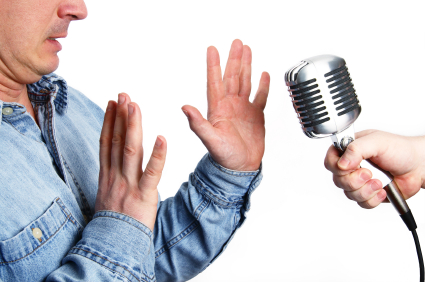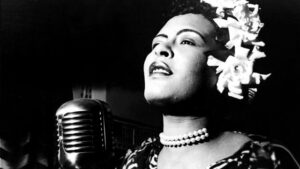
The symptoms of microphonebia include sweating, a dry mouth, a blank stare and a squeaky voice. Some people regard public speaking as a fearsome pursuit – hand them a microphone and it turns into a phobia.
The fear or discomfort associated with speaking into a microphone can be attributed to a phenomenon known as microphone anxiety or microphone phobia. This anxiety may stem from various psychological and social factors. Here are some reasons why people might be afraid of talking into a microphone:
Stage Fright: Microphone anxiety often overlaps with stage fright. Speaking into a microphone is often associated with public speaking or performing in front of an audience, which can trigger nervousness and anxiety.
Fear of Judgment: People may fear being judged or evaluated negatively when speaking into a microphone, especially if they are not accustomed to public speaking. The amplified nature of the microphone can make individuals feel more exposed.
Self-Consciousness: The awareness of being heard by a larger audience through the microphone can heighten self-consciousness. Individuals may become overly concerned about their voice, speech patterns, or potential mistakes.
Lack of Experience: For those who are not used to speaking into microphones, the unfamiliarity with the equipment and the process can contribute to anxiety. The fear of making technical errors or not being able to use the microphone properly may arise.
Communication Apprehension: Some people naturally experience communication apprehension, which is the fear or anxiety associated with various communication situations. Speaking into a microphone may trigger this apprehension.
Social Anxiety: Microphone anxiety can also be a manifestation of social anxiety, where individuals fear social interactions and the potential scrutiny from others.
Perceived Importance of the Message: If individuals perceive their message as highly important or if they are conveying sensitive information, the pressure to communicate effectively can contribute to microphone anxiety.
Addressing microphone anxiety often involves a combination of awareness, practice, and gradual exposure to microphone use. Public speaking courses, communication workshops, and practice sessions can help individuals build confidence and overcome their fear of speaking into a microphone. Additionally, creating a supportive and non-judgmental environment can contribute to reducing anxiety associated with microphone use.
If radio is something that you want to do as a career then Microphonebia is something that you are going to need to conquer very early on.
As i did more than 30 years radioshows here in Belgium i can say that talking in a microphone for broadcasting is much easier as talking in front of a live audience without a microphone. I am very modest in front of many people, but learned how to talk into the microphone when i was on live parties like weddings etc.
By turning my microphone volume up enough that even the people in the back could hear very clearly what I was saying, it gave me a feeling that I was in control of the audience. It might come across psychologically as “I shout loudest here, so I’m in charge here”. But that appears to work effectively. When I went to do a sound check beforehand, my biggest concern was that I had a good microphone available and that I could adjust it perfectly.
There is also a difference between just talking and talking through a microphone. Any mistakes you make will be noticed sooner because you speak louder. Don’t be fooled, put your mind to zero and you can’t live without that microphone!
Facts
Why does this simple metal device inspire so much horror in so many?
Would it be so scary if it were rainbow coloured with streamers hanging off the end? Would you then be able to hold yourself back from grabbing that microphone to sing, “We Are The World” and get everyone waving their hands in the air like they just don’t care? There’s no way you could ramble and go blank with that much love in the room.
A microphone is a magical device. It takes sound energy (your voice or instrument) and transforms it into electrical energy. This electrical energy can then be amplified or recorded, so that everyone can hear you.
And I guess that’s the scary part. What if you don’t want everyone to hear you? The amplification makes your voice bigger than you, potentially takes it beyond your control. And equipment can be unpredictable – what if it makes that awful screeching sound, or your voice booms out something inane. Ah, why are we so complicated? Why so many fears?
Fears are often imaginative and based on worry. One way to deal with microphonebia is to drag it into the light and examine it with keen scientific detachment. Let’s take a look how artists did react when the microphone was invented…

Billie Holiday was scared from the microphone :
When Billie Holiday first entered into a recording studio in 1933 at the age of 18, she was joined by some intimidating company. She had been brought there by John Hammond, a record promoter responsible for the career of Holiday’s idol, Bessie Smith. At the studio, she was set to close out a session led by Ethel Waters, at the time the most popular singer in New York. Benny Goodman, king of the jazz clarinet, was leading the recording session.
Yet the most intimidating element of the session was not a person but an object: Holiday was afraid of the microphone.
“Why do I have to sing into that thing? Why can’t I just sing like I do at the club?”
According to microphone scholar Paula Lockheart, Holiday’s anxieties about microphone singing were not uncommon: Some early recording studio performers were so intimidated by microphones that “there were cases when the microphone would be disguised as a lampshade to help calm the singer.”
Luckily for us, Lady Day never did resort to using a lampshade to calm her nerves: She not only embraced the use of the microphone, she revolutionized it. By bringing the “Harlem cabaret style” into the studio, she helped introduce a more subtle and restrained style of singing to recorded music. Here, John Szwed gives us the rundown on how Holiday — along with Bing Crosby, Frank Sinatra, and Johnnie Ray — helped to permanently change the way artists approached singing into the mic.
This style of singing would have previously been impossible to capture without the advances made in microphone technology in the ‘30s and ‘40s — it is not much of an exaggeration to say that without the engineers at Shure and RCA, there would have been no Billie Holiday. These advances not only made improvements to the sound quality of microphone recordings, but also the aesthetic qualities of the mics themselves.
As microphone technology shifted away from the bidirectional ribbon (like the diamond-shaped RCA 44) and towards more compact, unidirectional models, the recording instruments started to become oddly stylish. The classic Shure microphone, first introduced in the early ‘30s, was the Model 55, a luxurious design whose distinctive outer cage was based on the grille of the 1937 Oldsmobile Six convertible coupe. It was this model that became popular among crooners and rockers — including Sinatra and Elvis Presley — as well as politicos ranging from Kennedy to Castro. Even Holiday’s virtuosic jazz-singing rival, Ella Fitzgerald, was closely linked with the powerhouse design of the Model 55.